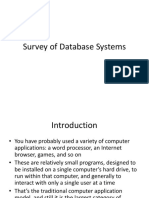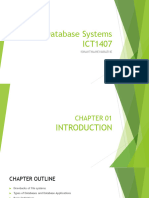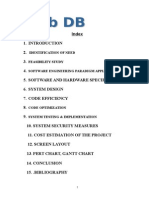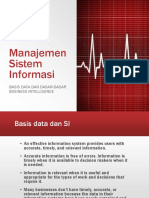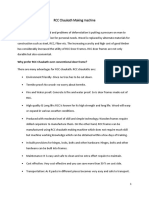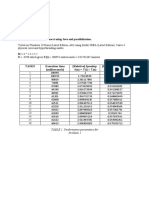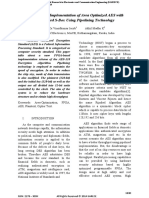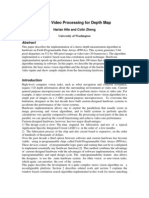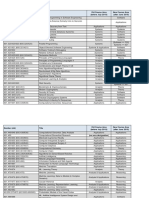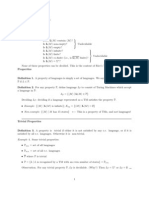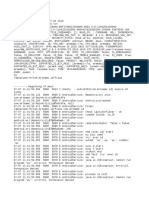Database and application programs
CPSC Seminar
Shibin Mohamed Iqbal
S2 M.Tech
14MCE11016
�Databases and Applications Programs
What is database?
A database is a collection of data that is related to particular topic or purpose. For example,
employee records in a filing cabinet, a collection of sales leads in a notebook, etc. A database is a
tool for collecting and organizing information. Databases can store information about people,
products, orders, or anything else. Many databases start as a list in a word-processing program
or spreadsheet. As the list grows bigger, redundancies and inconsistencies begin to appear in the
data.
Why do we need to use database?
Databases is used when
large amount of information would become unmanageable in spreadsheet form and is
related to a particular subject.
One need to maintain records for ingoing use
The information is subject to many changes such as change of address, pricing, changes,
etc.
Need for generating reports based on the information.
How does a database function?
The usefulness of a database organization is particularly evident in integrated design or
management environments. In these systems, numerous applications programs share a common
store of information. Data is drawn from the central database as needed by individual programs.
Information requests are typically performed by including pre-defined function calls to the
database management system within an application program. Results from one program are
stored in the database and can be used by subsequent programs without specialized translation
routines. Additionally, a user interface usually exists by which a project manager can directly
make queries to the database.
�Example:
An architectural system for design can provide an example of an integrated system. First, a
database can serve the role of storing a library of information on standard architectural features
and component properties. These standard components can be called from the database library
and introduced into a new design. The database can also store the description of a new design,
such as the number, type and location of individual building components. The design itself can
be composed using an interactive graphics program. This program would have the capability to
store a new or modified design in the database. A graphics program typically has the capability to
compose numerous, two or three dimensional views of a design, to introduce shading (to
represent shadows and provide greater realism to a perspective), and to allow editing (including
moving, replicating, or sizing individual components). Once a design is completed and its
description stored in a database, numerous analysis programs can be applied, such as:
structural analysis,
daylight contour programs to produce plots of available daylight in each room,
a heat loss computation program
area, volume and materials quantities calculations.
Production information can also be obtained from the integrated system, such as:
dimensioned plans, sections and elevations,
component specifications,
� construction detail specifications,
electrical layout,
system isometric drawings,
bills of quantities and materials.
The advantage of an integrated system of this sort is that each program need only be designed to
communicate with a single database. Accomplishing appropriate transformations of data between
each pair of programs would be much more difficult. Moreover, as new applications are required,
they can be added into an integrated system without extensive modifications to existing
programs. For example, a library of specifications language or a program for joint design might
be included in the design system described above. Similarly, a construction planning and cost
estimating system might also be added.
The use of integrated systems with open access to a database is not common for construction
activities at the current time. Typically, commercial systems have a closed architecture with
simple data files or a "captive," inaccessible database management system. However, the benefits
of an open architecture with an accessible database are considerable as new programs and
requirements become available over time.
Example: An Integrated System Design
�As an example, Figure illustrates the computer aided engineering (CAE) system
envisioned for the knowledge and information-intensive construction industry of the
future. In this system, comprehensive engineering and "business" databases support
different functions throughout the life time of a project. The construction phase itself
includes overlapping design and construction functions. During this construction
phase, computer aided design (CAD) and computer aided manufacturing (CAM) aids
are available to the project manager. Databases recording the "as-built" geometry and
specifications of a facility as well as the subsequent history can be particularly useful
during the use and maintenance life cycle phase of the facility. As changes or repairs
are needed, plans for the facility can be accessed from the database.
Database application programs
A computer program that interacts with the database by issuing an
appropriate request (typically an SQL statement) to the DBMS. Users
interact with the database through a number of application programs
(used to create & maintain the database & to generate information)
written in some programming language. Software programs used for
�storing, modifying, extracting, and searching for information within a
database.
There are dozens of database application programs available. Some of
the more popular database software applications include desktop
solutions like Microsoft Access and FileMaker Pro and server solutions
like MySQL, Microsoft SQL Server and Oracle.
Database application for various fields:
Accounting Applications:
Accounting system uses custom database application used to manage
financial data. Custom forms are used to record assets, liabilities,
inventory and the transactions between customers and suppliers. The
income statements, balance sheets, purchase orders and invoices
generated are custom reports based upon information that is entered into
the database.
Accounting applications can run on a single computer suitable for a small
business or in a networked shared environment to accommodate the
needs of multiple departments and locations in larger organizations.
"Microsoft Money," "Quicken," "QuickBooks" and "Peachtree" are accounting
systems built upon database applications.
CRM Applications
The customer relationship management system (CRM) is another example
of a database application that has been customized to manage the
marketing, sales, and support relationships between a business and its
customers. The ultimate goal is to maximize sales, minimize costs and
foster strategic customer relationships.
Simple contact management programs such as ACT, or the task manager
in Microsoft's Outlook can be customized to suit the needs of individuals
and small businesses. SAP, Salesforce.com, and Oracle's Siebel are robust CRM
database applications suitable for larger enterprises.
Web Applications
Many contemporary web sites are built using several database applications
simultaneously as core components. "Bestbuy.com," and "Amazon.com" use
database systems to store, update and present data about products for
sale. These Web sites also combine an accounting database system to
record sales transactions and a CRM database application to incorporate
feedback and drive a positive customer experience. The popular Web-
�based "Facebook" application is essentially a database built upon the
"MySQL" database system and is an indication of the increasing usage of
database applications as foundations for Web-based applications.
Construction projects
Construction projects inevitably generate enormous and complex sets of
information. Effectively managing this bulk of information to insure its
availability and accuracy is an important managerial task. Databases
enable handling and managing large volume of data required for the
projects. Oracle Primavera, SAP, Penta, Dataforma etc are some
commonly used database applications used in construction idustry.



